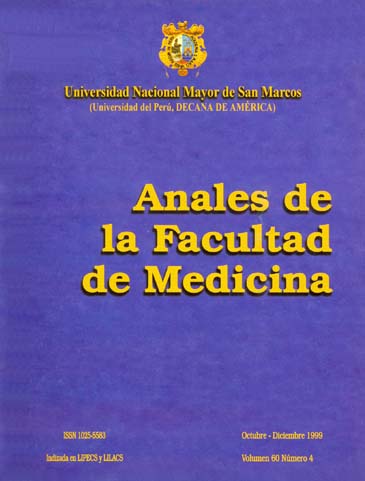Non-epidemic vibrios and Vibrio Cholerae O1 associated WITH acute diarrhea from cases given during "El Niño" Southern Oscillation (ENSO) 1998. Hospital Nacional Dos de Mayo
DOI:
https://doi.org/10.15381/anales.v60i4.4382Keywords:
Vibrio cholerae, Diarrhea, Vibrio infections, Vibrio, Vibrio parahaemolyticusAbstract
OBJECTIVE: Isolation and identification of Vibrio cholerae O1 and non-epidemic Vibrio species associated with acute diarrhea (AD) during the 1998 "El Niño" Southern Oscillation (ENSO). MATERIAL AND METHODS: During 1998 summer months, 70 stool samples from AD patients admitted in Hospital Nacional Dos de Mayo emergency room of Lima were cultured; TCBS Agar isolates were studied. Biochemical and serological tests were performed for identification of Vibrio cholerae O1. Non-epidemic vibrios and others pathogenic vibrios identification was performed according to Bergey’s Bacterial Systematic Manual (1994). RESULTS: Most cases were associated to Vibrio cholerae O1 as unique etiologic agent (64,3%) or related to the others Vibrio species (4,2%). Two cases involving Vibrio vulnificus (2,9%) and 3 with V. parahaemolyticus (4,3%) as etiologic agents of AD, are described. CONCLUSIONS: Vibrio cholerae O1 association with others non-epidemic vibrios lets us assume a direct relationship between evaluated diarrheic infections and ENSO.Downloads
Published
1999-12-31
Issue
Section
Trabajos originales
License
Copyright (c) 1999 Jimmy Ibarra Trujillo, Alvaro Delgado, Débora Alvarado

This work is licensed under a Creative Commons Attribution-NonCommercial-ShareAlike 4.0 International License.
Those authors who have publications with this magazine accept the following terms:
- Authors will retain their copyrights and guarantee the journal the right of first publication of their work, which will be simultaneously subject to Creative Commons Attribution License that allows third parties to share the work as long as its author and its first publication this magazine are indicated.
- Authors may adopt other non-exclusive licensing agreements for the distribution of the version of the published work (eg, deposit it in an institutional electronic file or publish it in a monographic volume) provided that the initial publication in this magazine is indicated.
- Authors are allowed and recommended to disseminate their work over the Internet (eg: in institutional telematic archives or on their website) before and during the submission process, which It can produce interesting exchanges and increase quotes from the published work. (See El efecto del acceso abierto ).
How to Cite
1.
Ibarra Trujillo J, Delgado A, Alvarado D. Non-epidemic vibrios and Vibrio Cholerae O1 associated WITH acute diarrhea from cases given during "El Niño" Southern Oscillation (ENSO) 1998. Hospital Nacional Dos de Mayo. An Fac med [Internet]. 1999 Dec. 31 [cited 2025 Jun. 7];60(4):251-6. Available from: https://revistasinvestigacion.unmsm.edu.pe/index.php/anales/article/view/4382



